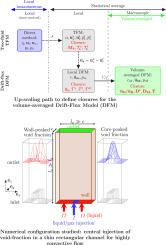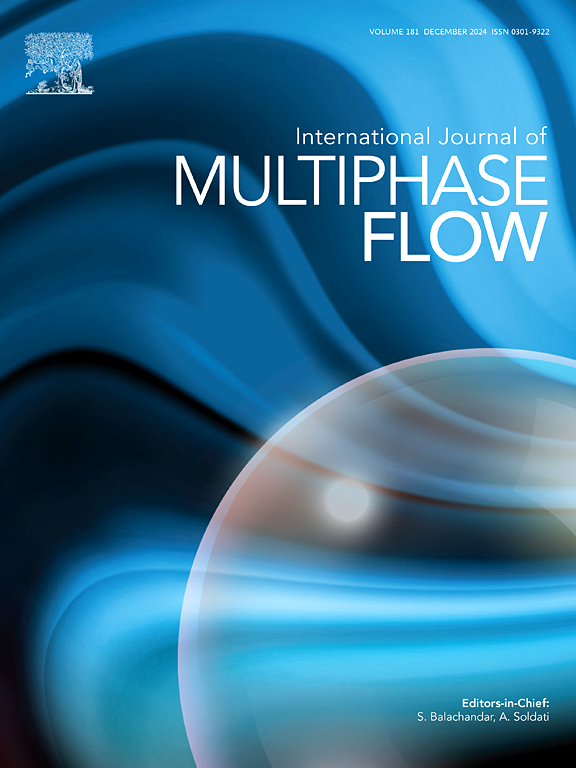高平流气泡流在窄矩形水道中的空隙漂移:从双流体局部模拟中得出的宏观漂移-流动模型
IF 3.6
2区 工程技术
Q1 MECHANICS
International Journal of Multiphase Flow
Pub Date : 2024-10-28
DOI:10.1016/j.ijmultiphaseflow.2024.105038
引用次数: 0
摘要
本文探讨了在工业应用中描述湍流两相流的简化模型问题。这项工作是基于 Bois(2021 年)理论推导的应用,将空间平均漂移-流动模型(DFM)与局部雷诺平均双流体模型(TFM)连接起来。它为校准闭合定律或基于更精细尺度描述提出新模型提供了新的机会。研究考虑了具有壁面空隙率剖面的高对流稳定气泡流。分散气泡的变形能力很弱。为应用于 DFM,开发了一个专门用于扁平矩形通道中空隙率分散的新模型。该模型根据绝热条件下加压水和蒸汽单分散气泡的参考局部欧拉-欧拉双流体模拟进行校准。考虑了 64 种条件,定期覆盖空隙率、雷诺数和 Eötvös 数的三维参数空间。所提出的新公式与本地 CFD 模拟的后处理预测结果非常吻合,同时大大减少了网格需求。该模型包含蒸汽浓度与混合物或相对速度之间的子过滤器相关性。这个从局部模拟中得出的模型在一个工业组件规模的代码中进行了后验,在该代码中实施并解决了完整的空间滤波 DFM。这项工作证明了基于双流体模拟的逐一模型开发和校准的优点和可行性。本文章由计算机程序翻译,如有差异,请以英文原文为准。

Void drift in narrow rectangular channels for highly advective bubbly flows: A macroscopic drift-flux model derived from two-fluid local simulations
This article addresses the issue of reduced models to describe turbulent two-phase flows in industrial applications. This work is an application based on Bois (2021) theoretical derivations to connect the spatially-averaged drift-flux model (DFM) to the local Reynolds-averaged two-fluid model (TFM). It presents new opportunities to calibrate closure laws or propose new models based on finer-scale descriptions. Highly convective steady bubbly flows with wall-peaking void fraction profiles are considered. Dispersed bubbles are weakly deformable. A new model dedicated to void fraction dispersion in flat rectangular channels is developed for application into the DFM. The model is calibrated based on reference local Euler–Euler two-fluid simulations of pressurised water and steam mono-dispersed bubbles, in adiabatic conditions. 64 conditions are considered to cover regularly the 3D parameter space in void fraction, Reynolds and Eötvös numbers. The new formulation proposed shows a very good fit with the post-processed predictions of local CFD simulations along with a substantial reduction in grid requirement. The model contains sub-filter correlations between vapour concentration and mixture or relative velocities. This model derived from local simulations is validated a posteriori in an industrial component scale code where the full space-filtered DFM is implemented and resolved. This work proves the benefits and feasibility of one-by-one model development and calibration based on two-fluid simulations.
求助全文
通过发布文献求助,成功后即可免费获取论文全文。
去求助
来源期刊
CiteScore
7.30
自引率
10.50%
发文量
244
审稿时长
4 months
期刊介绍:
The International Journal of Multiphase Flow publishes analytical, numerical and experimental articles of lasting interest. The scope of the journal includes all aspects of mass, momentum and energy exchange phenomena among different phases such as occur in disperse flows, gas–liquid and liquid–liquid flows, flows in porous media, boiling, granular flows and others.
The journal publishes full papers, brief communications and conference announcements.

 求助内容:
求助内容: 应助结果提醒方式:
应助结果提醒方式:


